Discover 15 hidden attractions, cool sights, and unusual things to do in Tübingen (Germany). Don't miss out on these must-see attractions: Stiftskirche Tübingen, Botanischer Garten der Universität Tübingen, and Hölderlinturm. Also, be sure to include Schloß Hohentübingen in your itinerary.
Below, you can find the list of the most amazing places you should visit in Tübingen (Baden-Württemberg).
Table of Contents
Stiftskirche Tübingen
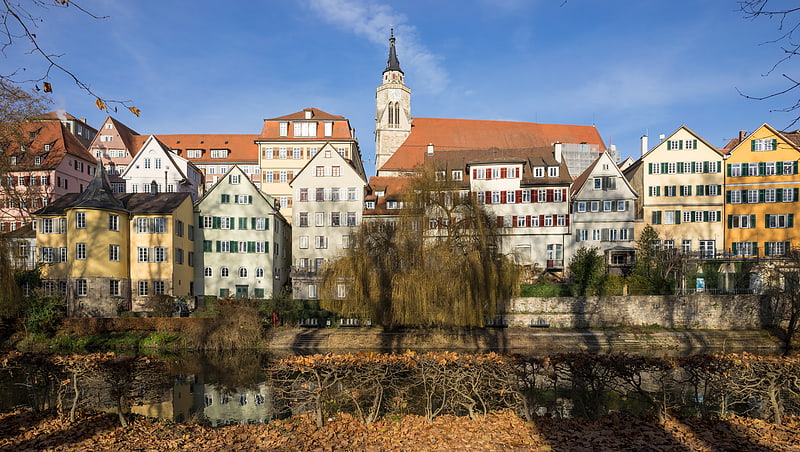
Also known as: Stiftskirche
Church in Tübingen, Germany. The Stiftskirche is a church located in Tübingen, Baden-Württemberg, Germany. It is a late gothic structure built by Peter von Koblenz in 1470. The stained glass windows were designed by Peter Hemmel of Andlau who also designed windows in Ulm, Augsburg, Nürnberg, München and Straßburg. It is the central landmark and, along with the rest of the city, the Stiftskirche was one of the first to convert to Martin Luther's Protestant church. It maintains several "Roman Catholic" features, such as patron saints.
Tower music is played from the church tower every Sunday.[1]
Address: Holzmarkt 1, 72070 Tübingen
Botanischer Garten der Universität Tübingen
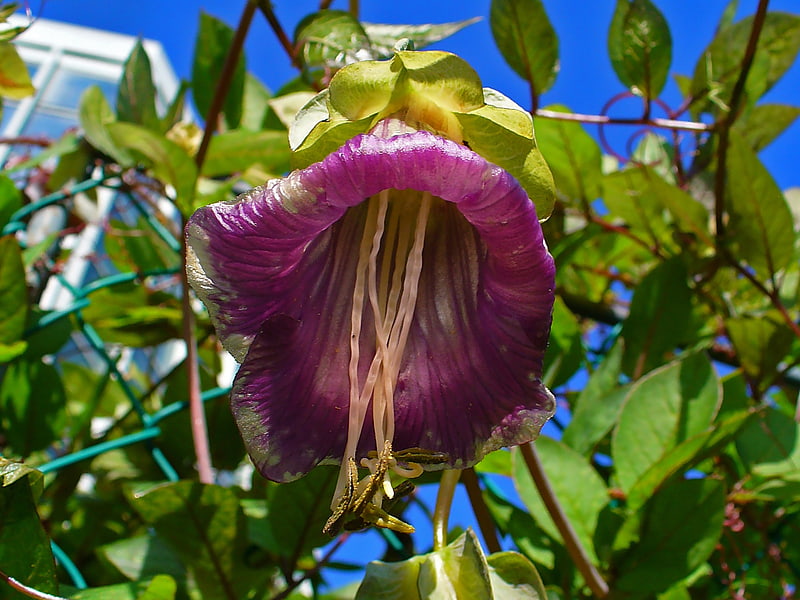
Also known as: Botanischer Garten Tübingen
Botanical garden in Tübingen, Germany. The Botanischer Garten der Universität Tübingen, also known as the Botanischer Garten Tübingen or the Neuer Botanischer Garten Tübingen, is a botanical garden and arboretum maintained by the University of Tübingen. It is located at Hartmeyerstrasse 123, Tübingen, Baden-Württemberg, Germany, and open daily.
The garden traces back to 1535 when medicinal plants were first grown by Leonhart Fuchs (1501-1566). In 1663 a Hortus Medicus was created by direction of Eberhard III, Duke of Württemberg (1614–74), with university gardener appointed in 1666. In 1681 Georg Balthasar Metzger (1623-1687) was named director, followed in 1688 by Rudolph Jacob Camerarius (1655-1721). The first greenhouse was completed in 1744, and noted botanist Johann Georg Gmelin (1709-1755) appointed director in 1751.
In 1804 a new garden was established by decree of King Frederick of Württemberg (1754-1816) under the leadership of Professor Carl Friedrich Kielmeyer (1765-1844), which grew and flourished throughout the first half of the nineteenth century. By 1809 it contained four greenhouses and a lecture hall, with its first seed catalog published in 1820, and from 1818-1825 its plants were reorganized according to the system of Antoine Laurent de Jussieu. In 1846 a substantial institute building was completed and by 1859 the garden cultivated 5,226 species. In 1866 the garden's final expansion was made with the purchase of adjacent private land. In 1878 Wilhelm Pfeffer (1845-1920) became director, who inaugurated a sizable palm house in 1886. Beginning in 1888, the garden was reorganized to the Eichler system.
Today's new botanical garden opened in 1969 with its first arboretum planting in the same year. In the mid 1970s the greenhouses were built, with a grass garden added in 1978-1979 and areas for plants of the Swiss and the Franconian Jura added in 1984. The alpine garden was expanded and reworked in the mid 1980s, with the Canary Island house added in 1987. In 1996 the Foerderkreis Botanical Garden was founded, and in 2000 a new medicinal plant department added. Today the garden contains more than 12,000 plant species, including major collections of Fuchsia (30 varieties) and Rhododendrons (150-180 varieties). The fuchsias are gathered in a glass and steel pavilion, built in 2001 for the 500th anniversary of the birth of Leonhart Fuchs.[2]
Address: Dr. Alexandra Kehl, Hartmeyerstraße 123, 72076 Tübingen
Hölderlinturm
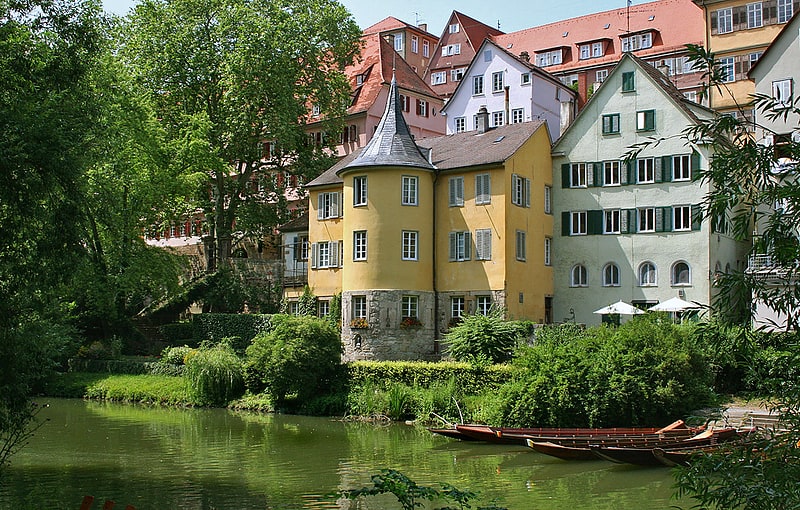
Museum in Tübingen, Germany. The Hölderlinturm is a building located in Tübingen, Germany that served as the place of residence and death in the final years of poet Friedrich Hölderlin. He lived there from May 3, 1807 until his death in 1843. The building is located on the Neckar riverfront and is one of the most popularly known sites in Tübingen.[3]
Address: Bursagasse 6, 72070 Tubingen
Schloß Hohentübingen
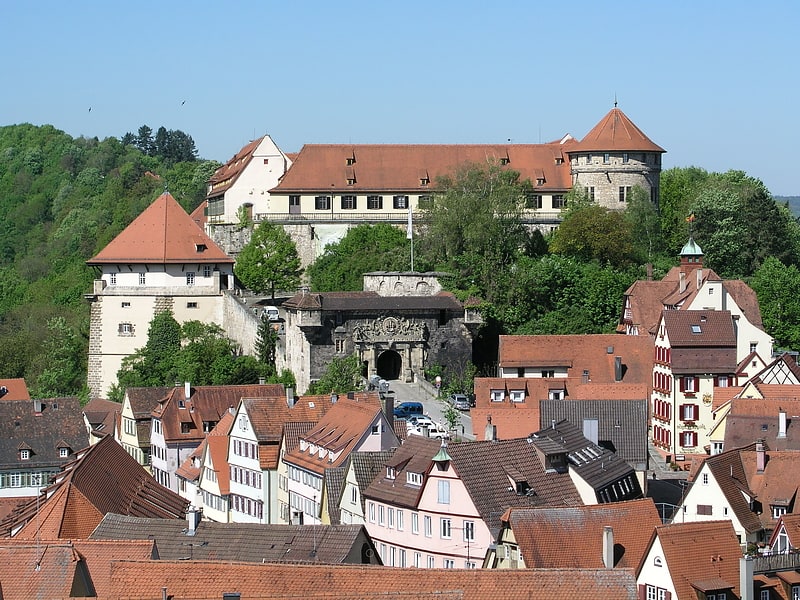
Hohentübingen Castle is centrally located in the city of Tübingen on a hilltop. It was built from the 11th century, expanded in the 16th century, and in its current form represents a mixture of medieval castle, modern castle as well as fortress.
Address: Burgsteige 11, 72070 Tübingen
Bebenhausen Abbey
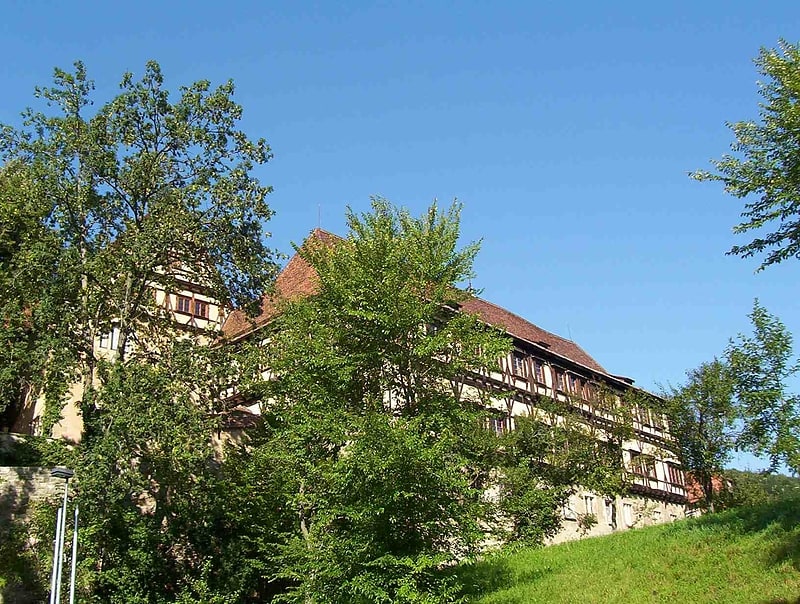
Also known as: Kloster Bebenhausen
Medieval monastery and hunting castle. Bebenhausen Abbey is a former Cistercian monastery complex located in Bebenhausen, Baden-Württemberg, Germany. The complex is also the location of Bebenhausen Palace, a hunting retreat created and maintained by two Kings of Württemberg. The complex was named a historic monument in 1974.
The monastery was established in the late 12th century by the Premonstratensians, but was ceded to the Cistercians in 1190. From the 13th to 15th centuries, Bebenhausen Abbey's fortunes grew rapidly until it became one of the richest monasteries in southern Germany. This period was also one of architectural expansion and renovation for the monastery. In the 14th century, it came under the dominion of the then County of Württemberg, whose rulers were later to dissolve the monastery in the 16th century. The abbey grounds were reused for a boarding school and Protestant seminary. Bebenhausen Abbey was also to play a brief role in post-World War II German politics, as the parliament of the French-controlled state of Württemberg-Hohenzollern devised their constitution at the monastery.
Bebenhausen Abbey also became a residence of the House of Württemberg as a hunting retreat and was especially favored by its rulers for its location in the Schönbuch. Württemberg's first king turned the south-eastern portion of the complex into a palace. After World War I, and the dissolution of the Kingdom of Württemberg, Bebenhausen Palace became the permanent residence of Württemberg's last King and Queen.[4]
Zimmertheater Tübingen
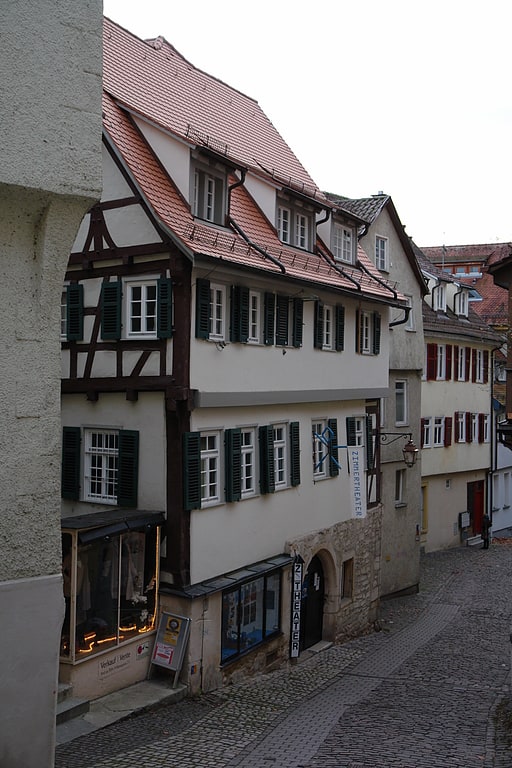
Theatre in Tübingen, Germany. Zimmertheater Tübingen is a very small theatre in Tübingen, Baden-Württemberg, Germany in close neighbourhood to the Hölderlinturm, where Friedrich Hölderlin spent his last years in life and near the Neckar river. It opened in 1958 and has two rooms for an audience of 60 and 80 Visitors.
- Website of the Zimmertheater (German)
Address: Bursagasse 16, 72070 Tubingen
Kunsthalle Tübingen
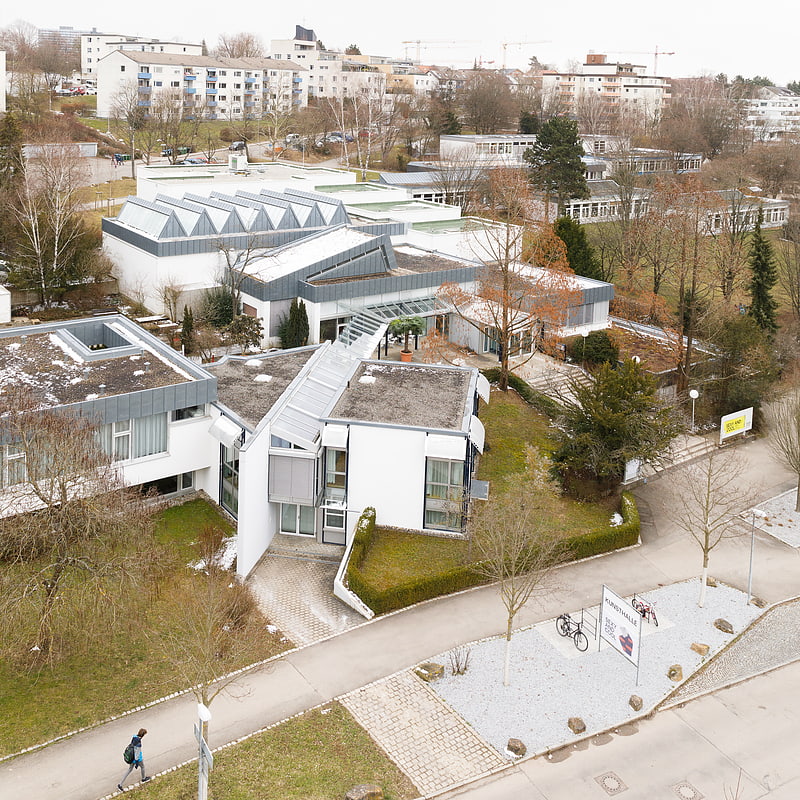
Museum in Tübingen, Germany. Kunsthalle Tübingen is the most famous art museum of the university town of Tübingen, Baden-Württemberg, Germany.
It was founded (and the erection of its building financed) in 1971 by Paula Zundel and Dr. Margarethe Fischer-Bosch, daughters of the industrialist Robert Bosch (founder of Robert Bosch GmbH) in memory of painter Georg Friedrich Zundel, Paula Zundel's late husband.
The building was erected during the big northern expansion of Tübingen in the 1960s and early 1970s, when the Wanne district (a.o.) was built almost from scratch as a residential area on the town's (formerly) rural northern hills.
For the first eleven years of its existence, it hosted mainly exhibitions of modern art and contemporary art. From 1982, it could also frequently present the works of painters of the classical modernity, e.g. Cézanne, Degas, Picasso, Renoir, Toulouse-Lautrec or Henri Rousseau, while keeping up the focus on modern art and contemporary art.
The first director of the Kunsthalle and, so far, for most of its existence, was Götz Adriani, from 1971 to 2005. His main theme was the leading role of the 19th century and early 20th-century French art for international modernity. Adriani managed to organize the first exhibitions in Germany of the works many of the French painters of the period of the late 19th and early 20th centuries at the Kunsthalle Tübingen. As for contemporary art, he was helpful in promoting the careers of artists such as George Segal (1972), Richard Hamilton (1974), and Claes Oldenburg (1975).
From 2006 to 2009, Martin Hellmond was the director at Kunsthalle. The current director (curator) is Dr. Nicole Fritz.
Since 2003, the museum is financed by a charitable non-profit foundation (before, it had been an institution of the city of Tübingen), consisting of private donations and the money of the Zundel family.[6]
Address: Philosophenweg 76, 72076 Tübingen
Alter Botanischer Garten Tübingen
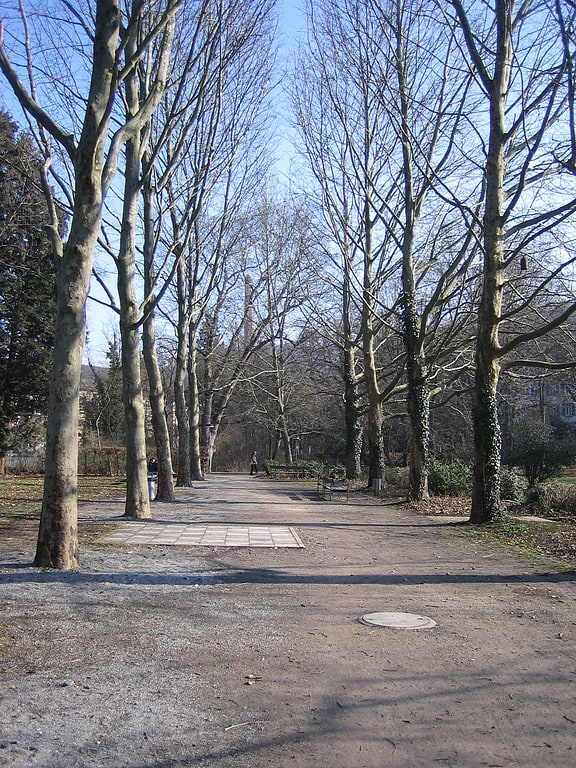
Also known as: Alter Botanischer Garten
Botanical garden in Tübingen, Germany. The Alter Botanischer Garten Tübingen is the former botanical garden of the University of Tübingen, now a municipal park. It is located at Am Stadtgraben 9, Tübingen, Baden-Württemberg, Germany, and open daily without charge.[7]
Address: Am Stadtgraben 9, 72070 Tubingen
Landestheater Tübingen

Theatre in Tübingen, Germany. Landestheater Tübingen is a theatre in Baden-Württemberg, Germany. It is known as 'LTT' for short, officially also 'Landestheater Württemberg-Hohenzollern Tübingen Reutlingen', is a cultural enterprise financed in Tübingen by public funds, donations and entrance fees. It puts on its mainly own productions, but also – partly foreign-language – guest performances. In addition to the so-called "evening game plan", it also has its own children's and youth theater division.
The Landestheater performs beyond with its productions for large and small stages, and with the Junge LTT also for kindergartens, classrooms etc. More than a quarter of its more than 900 performances a year are outside the theatre.[8]
Address: Tübingen, Eberhardstraße
Neckarinsel
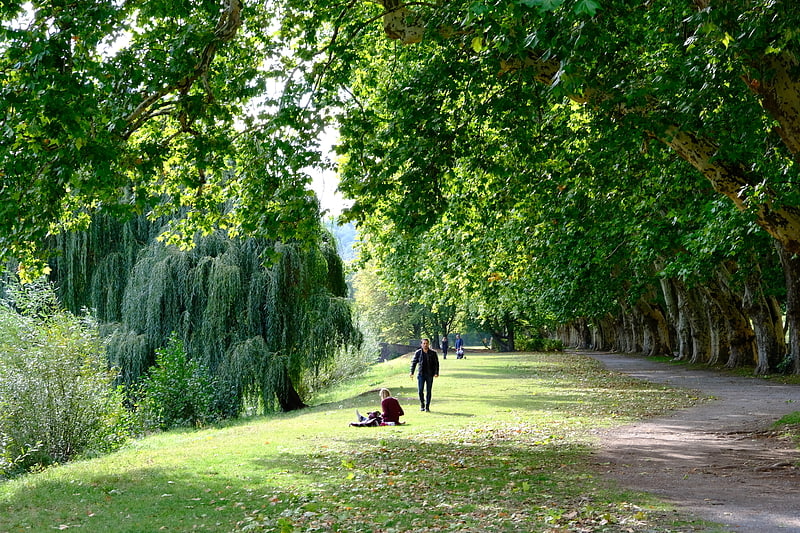
The Neckarinsel in Tübingen, Germany is an artificial, ⅔ mile long Neckar river island, which was created in the years 1910 and 1911 by branching off a parallel channel to regulate the water level of the Neckar river. It extends from the headland west of the Ammertal train bridge, the so-called Bügeleisen, to the Eberhard Bridge.[9]
Paul Horn-Arena
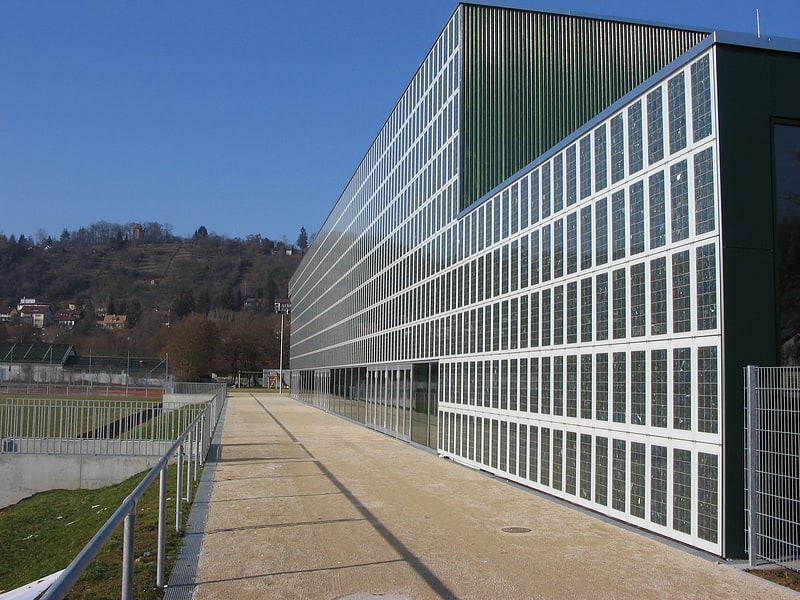
Sports arena in Tübingen, Germany. The Paul Horn-Arena is an indoor sporting arena located in Tübingen, Germany. The capacity of the arena is 3,132 people. It is currently home to the Walter Tigers Tübingen, TV 1893 Neuhausen and TV Rottenburg.[10]
Address: Europastrasse 50, 72072 Tubingen
City Hall
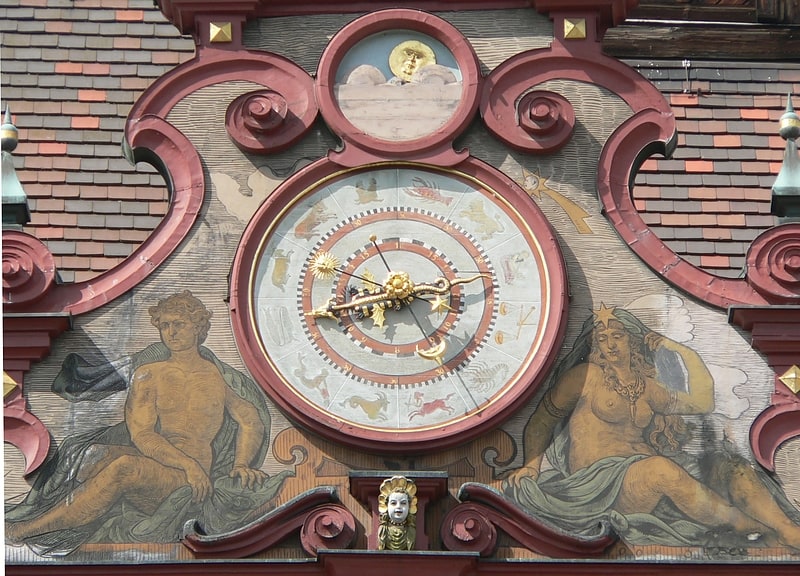
Tübingen's town hall was built starting in 1435 and was expanded and renovated in several phases. It served as the seat of the court of the state of Württemberg from about 1471 to 1805. In addition to images of justice, friezes and sgraffito paintings, the facade contains an astronomical clock. The building has a length of about 20 meters, is about 15 meters wide and has a height of about 20 meters to the eaves and about 30 meters to the ridge.
Address: 1 Am Markt, Tübingen
Pi-Chacán

Also known as: Pi Chacán
Pi-Chacán is a sculpture by the Peruvian artist Fernando de la Jara that has stood in the grounds of the University of Tübingen's Institute for Microbiology and Virology since 2001. Weighing 32 tons and measuring 4.2 × 1.7 × 1.7 metres, the sculpture is made from red Verona marble and represents a woman's vulva. It cost €120,000 and was originally intended to have a pool of water at its base, but budgetary constraints prevented this element of the design from being constructed.[11]
Jakobuskirche

The Jakobuskirche, also called Spitalkirche, in Tübingen is a Romanesque church, originally dedicated to St. James, which is now used by the Tübingen Protestant Jakobusgemeinde in the Tübingen church district. Together with the neighboring Salzstadel, it forms the historical center of Tübingen's lower town, the so-called Gôgei.
Address: Jakobsgasse 12, 72070 Tübingen
Universitätsbibliothek Tübingen

University library in Tübingen, Germany. The University Library of Tübingen is the main library of the University of Tübingen, one of the biggest and most renowned universities in Baden-Württemberg, Germany.
The people who worked for he University Library of Tübingen include Hermann Kurz, Adelbert von Keller, Robert von Mohl and Rudolf von Roth.
After the foundation of the university in 1477, the library was located at the so-called Sapienzhaus, later it was moved to the Alte Aula, the former main building of the university, then to Hohentübingen Castle (all of those in the old town (Altstadt) of Tübingen). The oldest building of the library at its current location (officially part of the town's architectural cultural heritage) was completed in 1912; the architect was Paul Bonatz. Large buildings were adjacently added in 1963 (the current main building), 1989 (Alte Waschhalle, renovated, formerly "old laundry hall" of the university) and 2003 (Ammerbau). The main library is located centrally in the university quarter of Tübingen, east of the old town, on Wilhelmstraße, near most of the university buildings of the arts, humanities and the social sciences faculties.
A second location of the library is on the outskirts of Tübingen, at Morgenstelle, where the faculties of medicine and the natural sciences are located.
In 1776 the library housed 15,000 items; by 1822, this number had increased to 60,000, by 1912 to 514,000 and by 1963 to 1.204 million. Today, the overall inventory is approximately 3.4 million items.
In 2008, the budget was just over 9 million Euro, the number of staff was 128. Around 340,000 people, more than three times the population of the town of Tübingen, were registered as users (as usage is not only limited to enrolled students of the university (approx. 28,000), but anyone with an address in Baden-Württemberg can freely use it).[12]
Address: Wilhelmstraße 32, 72074 Tübingen